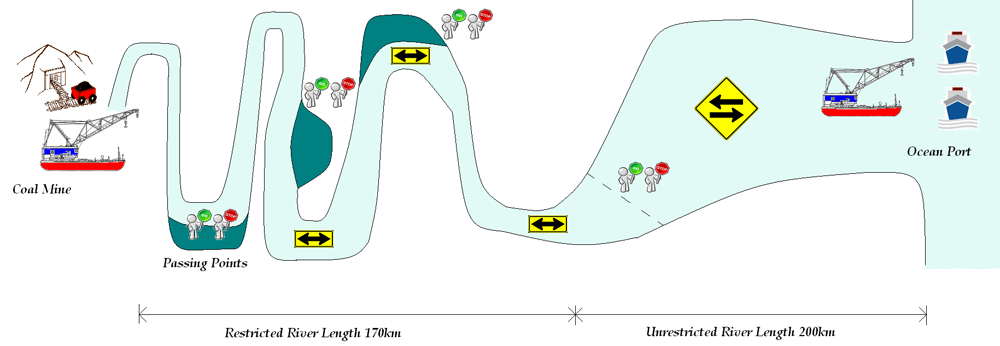Simulation of Coal-Barging on a River
Overview
The Problem:
How many tonnes of coal per annum can be transported along a river of variable navigability?
The Data Analysis Australia Approach:
- To develop a model to simulate barges carrying coal along a river taking into consideration sensitivities to certain elements such as navigability of the river, number of barge passing-points, ship arrival rates and reliability, and the number of barges running.
The Result:
- The simulation results aided the mining company in deciding that it would not be feasible to use barges to transport the amount of coal required from barge loading terminal to transhipment location.
The Problem
A coal mining company was intending to use a river to barge coal from an inland barge-loading terminal to an ocean port, for export. The river had variable navigability, according to both its natural topography and the seasonal rainfall. Data Analysis Australia was asked to determine the feasibility of such a process, and to estimate the limits (in tonnes per year) that could be transported. The coal barging approach was an option for the company as an interim way of transporting the coal whilst a higher potential capacity mode of transport was being developed.
The river on which the barges were to travel is particularly sinuous, with many bends and several narrow stretches. A bathymetric study showed the river to be navigable for most of the year for a given barge size of 5,000 tonnes. However, some parts of the river would be difficult and might require special provisions for passing and the clearing of some bends. This would require facilities such as additional tugs at some of these sites and locations where barges travelling upstream could pass those travelling downstream would be limited.

Why Use Statistics?
The solution to this problem is not simple due to the many sources of variability, for example in the speed at which the barges travel up and down stream, in the loading and unloading rates of the barges and the arrival of the ships to the port. As an organisation that primarily specialises in statistics, Data Analysis Australia is ideally suited to tackle the variation in complex real-life problems of this sort.
Variation of this type can lead to congestion that dramatically limits the capacity of a system. Failure to take into consideration the variation in each component can mean that the combined effect of the different sources of variation on the final result is not accounted for, which can lead to making the wrong decision and can ultimately kill a project.
The Data Analysis Australia Approach
Data Analysis Australia developed a simulation model using the Extend simulation software package. The simulation study aimed to optimise the system to maximise the quantity of coal that could be transported down a river. Several areas that may affect productivity were identified, these being:
- The number of barges available to transport the coal;
- The number of passing points on the river;
- The prioritisation of barges up and downstream; and
- The variation in the arrival times of the ships to the transhipment location.
There was limited data available to calibrate the parameters in the simulation model. Therefore, reasonable assumptions were made relating to barge and ship capacities, travel times, barge loading and unloading rates and passing points on the river. Barge prioritisation required special effort, since there was a need to simulate what reasonable operating rules might achieve. The lack of complete data made it even more important to understand the possible variation in the parameter values used.
Data Analysis Australia created a baseline scenario using the most likely values for each of these areas and then proceeded to test the sensitivity of these factors to the tonnes transported per year. The 'most likely' values for these parameters were determined through extensive consultation with the client.
Each simulation corresponded to one year of operation after allowing a one-year lead in time to enable the simulation to settle to a steady state. Each simulation run was completed in a matter of seconds of computing time. Data Analysis Australia recorded critical outputs from the model such as queue lengths, average waiting times, number of barges unloaded with coal, as well as total coal transported in millions of tonnes.
The Result
The results of several scenarios showed that it was feasible to transport up to approximately five million tonnes of coal per year. However, this was approaching the limit of what would be feasible. The results of the analyses enabled the mining company to make the decision not to pursue barges as a viable solution of transporting coal from a barge-loading terminal to an ocean port location. More importantly, it removed the risk of implementing a system that would fail to reach the desired capacity.
December 2010
